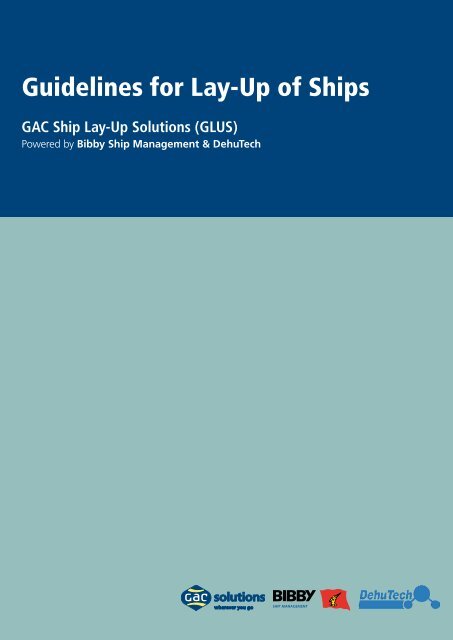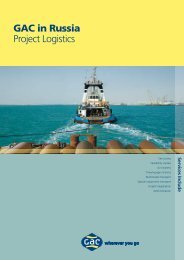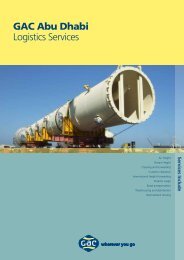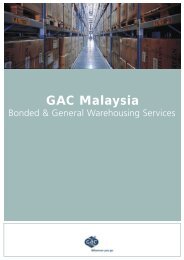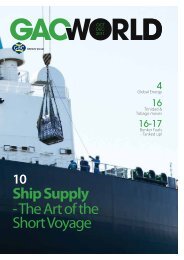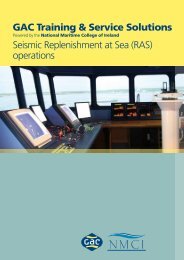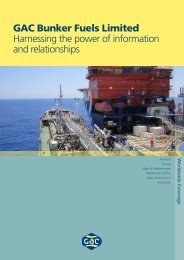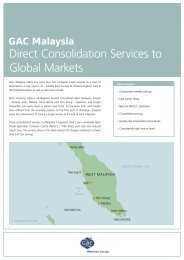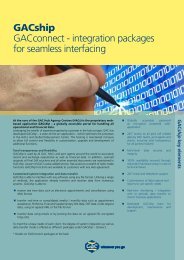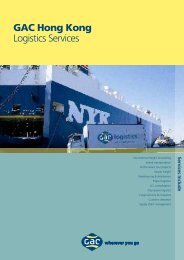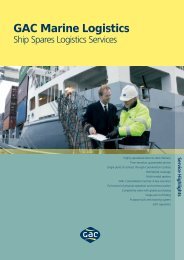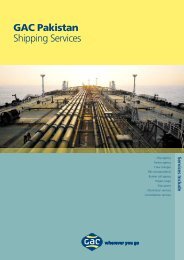Guidelines for Lay-Up of Ships - GAC
Guidelines for Lay-Up of Ships - GAC
Guidelines for Lay-Up of Ships - GAC
- No tags were found...
Create successful ePaper yourself
Turn your PDF publications into a flip-book with our unique Google optimized e-Paper software.
<strong>Guidelines</strong> <strong>for</strong> <strong>Lay</strong>-<strong>Up</strong> <strong>of</strong> <strong>Ships</strong><strong>GAC</strong> Ship <strong>Lay</strong>-<strong>Up</strong> Solutions (GLUS)Powered by Bibby Ship Management & DehuTech
<strong>GAC</strong> Ship <strong>Lay</strong>-<strong>Up</strong> SolutionsPowered by Bibby Ship Management & DehuTechIndex• Introduction P4• GLUS Set-<strong>Up</strong> and Partners P4• GLUS <strong>Lay</strong>-<strong>Up</strong> Sites P5• Class and Certification P8• Protection and Indemnity (P&I) P8• Hull and Machinery (H&M) Insurance P8• <strong>Lay</strong>-<strong>Up</strong> Options P9• Preparation <strong>for</strong> <strong>Lay</strong>-<strong>Up</strong> P10• Preservation and Maintenance P12• Underwater Services P18• Documentation and Record Keeping P19• Safety and Security P20• Crewing and Inspections P21• <strong>GAC</strong> Marine Logistics P22• <strong>GAC</strong> Ship Agency P23• Re-Commissioning and Start-<strong>Up</strong> P233
<strong>GAC</strong> Ship <strong>Lay</strong>-<strong>Up</strong> SolutionsPowered by Bibby Ship Management & DehuTechIntroduction<strong>Lay</strong>ing-up ships makes good business sense during tough times. Not only does it allow ship owners and operators to avoid non-pr<strong>of</strong>itablejourneys and over supply, it also reduces wear and tear, crew costs, fuel consumption and insurance premiums during the idle period.<strong>GAC</strong> Ship <strong>Lay</strong>-<strong>Up</strong> Services (GLUS) has prepared these guidelines as support <strong>for</strong> customers that opt to lay-up their vessels – whether it be<strong>for</strong> shorter or longer periods – and to provide a clear overview <strong>of</strong> the lay-up methods and services available.GLUS Set-<strong>Up</strong> and Partners<strong>GAC</strong> Ship <strong>Lay</strong>-<strong>Up</strong> Solutions (GLUS) works with “best in class” partners under a single umbrella to provide the broad range <strong>of</strong> skills andexperience required <strong>for</strong> the comprehensive care <strong>of</strong> a ship being laid-up.Part <strong>of</strong> the <strong>GAC</strong> Solutions stable, GLUS is a strategic partnership with Bibby Ship Management Ltd and DehuTech AB. It aims to assistcustomers at a range <strong>of</strong> lay-up locations around the world with a range <strong>of</strong> services and products including: identification <strong>of</strong> lay-uplocations, ship agency, logistics support, technical management, crewing, dehumidification, surveillance and preparation <strong>for</strong> reactivation.<strong>GAC</strong> Solutions<strong>GAC</strong> Ship <strong>Lay</strong>-<strong>Up</strong> Solutions – Powered by Bibby Ship Management and DehuTech is a unit under <strong>GAC</strong> Solutions, a special business area <strong>of</strong>the <strong>GAC</strong> Group, set up to provide value-added products to the shipping and marine industries. It combines <strong>GAC</strong>’s knowledge and longstanding relationships with its shipping, logistics and marine customers with the products from world-leading suppliers. Other servicesrange from class-approved fire, rescue & safety systems / services, onboard and <strong>of</strong>fice based weather routing solutions, protectivesolutions (anti-piracy), workwear and the list is growing.Bibby Ship ManagementBibby Ship Management’s dedication to quality brings economic advantages to its clients. In particular, the company’s adherence tostringent quality management systems, industry <strong>for</strong>esight and pr<strong>of</strong>essional integrity means that the long term interests <strong>of</strong> clients areprioritised. Bibby Ship Management has a global presence and is part <strong>of</strong> Bibby Line Group, with over 200 years <strong>of</strong> marine heritage.DehuTech ABDehuTech is a Swedish company that exports desiccant dehumidifiers to countries outside Sweden. The dehumidifiers are developed,designed and manufactured in Sweden and are used <strong>for</strong> a vast number <strong>of</strong> different industrial applications. DehuTech AB is a subsidiary<strong>of</strong> Fuktontroll AB, Sweden which has been active in the domestic Swedish market since 1980.<strong>GAC</strong> Ship- <strong>Lay</strong>-<strong>Up</strong>Solutions helps safekeepyour business withour comprehensive range<strong>of</strong> services delivered bypr<strong>of</strong>essionals.4
<strong>GAC</strong> Ship <strong>Lay</strong>-<strong>Up</strong> SolutionsPowered by Bibby Ship Management & DehuTechPreparation <strong>for</strong> <strong>Lay</strong>-<strong>Up</strong>The following GLUS activities generally apply to “Cold” and “Long-Term” <strong>Lay</strong>ups,but in some circumstances may also apply to the “Hot” or “Warm” <strong>Lay</strong>-upmodes.General criteria <strong>for</strong> lay-up:• Apertures / inspection openings where covers have been removed <strong>for</strong> air circulationshould be covered with fine mesh wire gauze to prevent ingress <strong>of</strong> <strong>for</strong>eign matter.• External equipment moved to dehumidified spaces should be properly stowed, thestorage location carefully recorded and the normal location site labelled.• All machinery and equipment components removed from their normal location shouldbe properly labelled and stowed adjacent to the parent unit within dehumidifiedspaces. The parent unit should be marked with appropriate labels indicating thelocation <strong>of</strong> such components.• Fuel oil lines should be isolated, and injectors removed, cleaned, coated with oil andstowed.• Internal combustion engine cylinders must be lubricated with lube oil while engine isturned by hand.• Cooling systems should be drained <strong>of</strong> water and left open to dehumidified atmosphere.Where neoprene sealing rings are fitted, system should be left charged to prevent dryoutand corrosion inhibitors added.• Sea water systems should be drained and opened to dehumidified atmosphere.• Selected inspection covers should be removed to allow free circulation <strong>of</strong> dry airthroughout the machine.• Exhaust lines should be blanked.• Underwater areas must be adequately protected with sacrificial anodes and hullpotential to a satisfactory level.• During lay-up, ballast tanks should be maintained either full or empty. Full tanksmay be protected by means <strong>of</strong> corrosion inhibitors or sacrificial anodes. Empty tanksshould be dried out to minimise corrosion. All sludge and mud should be removedprior to lay-up.• All sea valves should be fitted with internal blank flanges. External sea suctions shouldbe closed <strong>of</strong>f by divers using fibreglass blanks fitted with neoprene seals. Blanksshould have a pocket to allow a biocide brick to be inserted to prevent marine growthin the grids.• The stern seal should be checked externally by divers to ensure there are no ropes orlines penetrating the seal assembly that could result in leakage.• Safe access to the vessel must be provided <strong>for</strong> watchmen and maintenance crews.Special preparation is requiredbe<strong>for</strong>e a vessel can be laid up.11
<strong>GAC</strong> Ship <strong>Lay</strong>-<strong>Up</strong> SolutionsPowered by Bibby Ship Management & DehuTechPreservation and MaintenanceThe nature and extent <strong>of</strong> preservation required <strong>for</strong> each laid-up vessel is determined by:• lay-up duration.• lay-up location and corresponding climatic conditions.• general condition <strong>of</strong> the vessel (to be assessed and corrective maintenance per<strong>for</strong>med in liaison with the owners prior to lay-up).• conditions governing re-commissioning.Corrosion is a major problem when laying-up a vessel and all measures should be made to reduce and even eradicate the risk. Anymeasures taken must be recorded <strong>for</strong> reference as a check list when the ship is re-commissioned. The following methods are used toreduce corrosion:• Total and effective sealing <strong>of</strong> major accommodation and machinery spaces from external atmospheric conditions, particularly wherehigh humidity levels exist.• Controlled dehumidification <strong>of</strong> internal air spaces (including void spaces within machinery and pipelines) to prevent sweating andhumidity corrosion damage, as well as moisture absorption into electrical cables and fittings.• Application <strong>of</strong> preservatives and suitable lubricants to external equipment and machinery not within the dehumidified spaces.• Hull cathodic protection to be maintained, and <strong>for</strong> long term lay-up ballast tanks to be suitably protected. This could mean that theyare totally emptied, cleaned and dried out or fully ballasted to remove air pockets and corrosion inhibitor added.• Regular turning <strong>of</strong> rotating machinery to prevent corrosion damage to bearings, seizure and component distortion. Equipment wouldbe identified and highlighted on the check lists <strong>for</strong> this purpose.Controlled humidity space sealing and dehumidificationHumidity can present risks <strong>for</strong> laid-up vessels. Corrosion and other moisture damage can be costly and cause serious delays when the timecomes to re-activate. GLUS provides a range <strong>of</strong> dehumidifying services to reduce the risk <strong>of</strong> such damage.The atmosphere within designated spaces should be kept within certain set limits to ensure preservation <strong>of</strong> equipment. In somegeographical location or during certain seasons, some may consider this to be unnecessary. However, this is a fallacy and dehumidificationrequirements should never be underestimated.Main Machinery spaces should be maintained at 30 – 50% RHAccommodation spaces should be maintained at 45 – 55% RHAll openings – including doors, windows, port holes, vent/extraction apertures, sanitary outlets, scuppers, drains and air intake grids –should be secured and sealed using proven methods. Limited means <strong>of</strong> access to be retained.Dehumidification units <strong>of</strong> adequate capacity need to be sited and installed, together with associated distribution trunking to achievesufficient air circulation both within the ‘controlled’ spaces as a whole and through major individual items <strong>of</strong> machinery, equipmentand systems within those spaces. The circulation <strong>of</strong> dry air will be arranged such that desired levels <strong>of</strong> relative humidity will be achievedthroughout. All water / steam systems and tanks within the controlled spaces, except those required <strong>for</strong> the lay-up operation will bedrained free <strong>of</strong> water (including bilge areas), dried and left open to dehumidified atmosphere. Non-return valve internals will be removedwhere necessary to improve air circulation within the systems.12
<strong>GAC</strong> Ship <strong>Lay</strong>-<strong>Up</strong> SolutionsPowered by Bibby Ship Management & DehuTechPreservation and MaintenanceDiesel enginesEngines that have been run on heavy fuel oil should operate on diesel fuel <strong>for</strong> a sufficient time be<strong>for</strong>e shut down to ensure that the fuellines and the injection system are free from heavy fuel oil.Engine shut-down up to 3 monthsPreservation measures are usually unnecessary <strong>for</strong> shut-down periods <strong>of</strong> up to 3 months. Only during cold times <strong>of</strong> the year is itnecessary either to keep the engine room temperature above freezing point or add antifreeze to the fresh cooling water. The mixingratio depends on anticipated temperatures and should be determined in accordance with manufacturer’s instructions. Lubricating oilshould be subjected to thorough separation. The moisture content must not exceed a maximum limit <strong>of</strong> 0.1%. Any decision regardingthe further use <strong>of</strong> old oil should be preceded by an analysis.Approximately every two weeks, the engine should be lubricated and turned through at least two revolutions, taking care to ensurethat on each occasion the crankshaft comes to rest in a different position. Where engines are fitted with cylinder lubricators, it isrecommended that these should also be turned by hand during the rotation <strong>of</strong> the engine. After turning, the indicator cocks should bere-closed.Engine shut-down <strong>for</strong> longer periodsProtection <strong>of</strong> the combustion chambers and fuel injection systemsThe following preservation procedure should be applied in the interests <strong>of</strong> internal protection: A mixture <strong>of</strong> gas oil and 20% by volumeanti-corrosion oil should be fed into the fuel system. While the engine is running at reduced revolutions with an increased lubricatingoil pressure, the air intake apertures should be closed, causing the engine to come to a stop without ignition. Another possibility is touse an atomiser to spray in anti-corrosion oil through the openings in the combustion chamber (injection valve or inspection parts). Thecompatibility <strong>of</strong> the anti-corrosion oil with the circulating oil is to be confirmed by the manufacturers.Engine casingFor smaller engine casings it is recommended that the crankcase vents and all apertures provided on the engine are sealed to prevent anyair. In<strong>for</strong>mation about the condition <strong>of</strong> the oil can also be obtained by analysis. The limit values specified by the engine manufacturersmust not be exceeded. Where an oil change has been carried out, the engine should have run with the new oil <strong>for</strong> at least 15 minutes.If the shut-down period exceeds 6 months, the oil filter and casing require special attention. They should be cleaned and filled withanticorrosion oil.The engine entablature <strong>of</strong> large engines must be ventilated. Relative humidity <strong>of</strong> no more than 35% should be maintained. This canbe achieved by means <strong>of</strong> an air-drier. According to type, air-driers with a closed circuit (air recycled to the drier) or an open circuit (airdischarged into the engine room) may be used. Care must be taken to ensure adequate air circulation in the engine casing. Where anair-drier is also used to keep the engine room dry, separate ventilation <strong>of</strong> the engine casing is essential. If closed circuit air-driers are usedin the engine room, all apertures are to be closed. Gears, camshaft and all control elements should be protected with anticorrosion oil.Turbocharger and exhaust line uptakesThe exhaust line outlet should be sealed. Drain cocks should be opened. Ideally, in the engine room, air should be able to circulateinside the exhaust line, with the air outlet located as close as possible to the end to the exhaust line. The turbocharger intake filters mustbe cleaned and protected according to their design requirements. Internal parts <strong>of</strong> the turbocharger should also be protected againstcorrosion. The rotor should be arrested and all openings closed. Charging air coolers should be drained. Attachments made <strong>of</strong> materialswhich are not resistant to seawater must be protected.General - Cooling water spacesAnticorrosion oil should be added to the fresh cooling water be<strong>for</strong>e lay-up. After the ship has been taken out <strong>of</strong> service, fresh watersystems should be drained. Where complete drainage is not feasible; antifreeze should be added prior to shut-down. Confirmationshould be obtained from the manufactures that the anticorrosion oil and the antifreeze are compatible with each other and with othercooling water additives as well as with seals and hoses.Starting air systemThe entire starting air system, including air cylinders, should be protected and depressurised wherever possible. Air cylinders shouldbe opened. Pneumatic control systems should also be depressurised. All drainage devices should be left open. The condition <strong>of</strong> theprotection must be checked regularly.14
<strong>GAC</strong> Ship <strong>Lay</strong>-<strong>Up</strong> SolutionsPowered by Bibby Ship Management & DehuTechPreservation and MaintenanceBoilers (measures <strong>for</strong> combustion gas spaces)Boilers run on heavy fuel oil should be changed over to diesel oil prior to shut-down. The fuel piping system should be free from heavyfuel oil completely.The boiler should be cleaned on the furnace side <strong>of</strong> all soot and combustion residues which can absorb moisture and lead to corrosion.Any defects, such as leakages, must be repaired. After cleaning, the boiler should be dried by heating (<strong>for</strong> example, by briefly firing theburner(s) on diesel oil).Exposed external parts <strong>of</strong> the boiler should be protected as necessary. Exhaust pipes are to be covered and protected from the elements.Silica gel should be placed within the furnace to maintain a dry atmosphere. To maintain dry air within the boiler, dried air may becirculated within a closed cycle around the furnace / tubes and uptakes. Alternatively, dried air may be passed through an open circuitwith the exhaust air leaving the top <strong>of</strong> the boiler and directed back into the engine room.Seawater cooling systemsSeawater systems which are not in operation should be drained. It is advisable to flush out lines and heat exchangers with fresh waterand then dry. All drain cocks should be left open. Valve spindles should be tested from time to time to ensure that they can move freely.As far as possible, all bottom and shipside valves should be closed. Valve spindles should be greased.It must be remembered that systems or parts <strong>of</strong> systems may be opened <strong>for</strong> he purposes <strong>of</strong> preservation. All strainers should be drained,mopped dry and left open together with selected valves, thus permitting the circulation <strong>of</strong> dry air.Fresh water cooling systemsFresh water cooling systems should be drained and dried. All drain cocks should be left open. Expansion tanks should be cleaned andprotected. Interiors should be drained and dried out. Inspection covers and drain plugs should be removed <strong>for</strong> air circulation, and suctionstrainers drained and left open.Refrigerating equipmentBe<strong>for</strong>e refrigerating plant is shut down, care must be taken to ensure that there are no leaks in the coolant circuit. Coolant should bedrawn <strong>of</strong>f into the condenser or collector. Condensers should be opened on the water side and dried. Refrigerating spaces should beventilated.Deck machineryDeck machinery should be regularly activated and should, wherever possible, be preserved internally and externally and covered over.Where the laying-up conditions make this necessary, anchor and mooring winches should be kept ready <strong>for</strong> use. Steam-powered winchesmay, if necessary, be operated by compressed air, and in this case at least one air receiver <strong>of</strong> appropriate size should be held in readiness.Air compressors and systemsLube oil should be drained from sumps whilst warm, system recharged with clean oil and the machine run <strong>for</strong> 5 minutes be<strong>for</strong>e final shutdown.Unless the compressor is required <strong>for</strong> use during lay-up routines, covers and valves on all stages should be removed and cylinderslubricated. Air filters and inspection covers should be removed and header drains left open to allow free circulation <strong>of</strong> air. Receiversshould be drained and mopped dry and drains and inspection doors left open.Fuel oil purifiersInternals should be removed, cleaned, coated with grease and stowed. Bowl and crankcase should be left open to atmosphere. Thecrankcase should be drained, cleaned and charged with new oil <strong>of</strong> owners’ supply.Steering gearThe entire steering gear should be subjected to a service test once a week. Provision should be made <strong>for</strong> the adequate lubrication <strong>of</strong> therudder carrier bearings. Exposed parts must be protected.Bilge level alarmsThe bilge level alarm system should be kept operative. Where such a system is not installed, a temporary alarm system should be fitted.Valves in seawater systems which are not in operation should be closed. The bilge pump should be kept ready <strong>for</strong> use.15
<strong>GAC</strong> Ship <strong>Lay</strong>-<strong>Up</strong> SolutionsPowered by Bibby Ship Management & DehuTechPreservation and MaintenanceAccommodationIf the vessel is laid-up unmanned:• In addition to external sealing arrangements described in controlled humidity space sealing and dehumidification, all sanitary fittingsshould have openings sealed and water supply systems isolated.• All provisions stores and dry stores should be emptied, cleaned and doors secured in open position.• All cabin linen should be stowed in a central locker in clean condition, mattresses stood on edge and all cupboard and cabin doorssecured in open position.• All access alleyway decks should covered with H/D polythene. If carpets are fitted these should be cleaned then covered with abreathable fabric <strong>for</strong> protection.• All navigation and communication systems should be isolated (except local VHF Trans/receiver) and room doors left open to ensuregood air circulation.• Accommodation spaces should be sprayed with insecticide to prevent infestations <strong>of</strong> cockroaches, etc.Electrical Installation & Equipment• All electrical equipment and cables must be in good condition, particularly those required during lay-up such as engine room andaccommodation lighting systems and main auxiliary switchboards. Electrical power may be provided by a portable diesel generatoror shore power when available. This will minimise utilisation <strong>of</strong> the vessel’s own emergency generator which can then be laid-up.Temporary cables should be supplied and safely installed as necessary.• Lead batteries should be regularly recharged. Automatic chargers should be kept in operation. The acid level <strong>of</strong> batteries must bechecked every month.• Electric motors and generators should be heated; low-voltage heating via the windings is recommended. Small motors, switch boxes,electronics cabinets and switchboards should be kept dry and, where necessary, sealed using moisture absorbent materials.• Full insulation tests should be carried out on all distribution systems and motors prior to lay-up, and readings recorded and submittedto owner on a regular basis.• The condition <strong>of</strong> external motors should be monitored by taking regular insulation readings. If the condition deteriorates to a pointwhere it would be detrimental to the motor, where possible, it should be removed and stowed in a dehumidified area.• All starters, control panels and distribution boards within dehumidified spaces, where safe to do so, should have access doorspartially opened to allow free circulation <strong>of</strong> dry air.Main Boilers• Gas sideBoilers run on heavy fuel oil should be converted to diesel oil prior to shut-down. Steps should be taken to ensure that the entirefuel piping system is free from heavy fuel oil. The shut-down boiler should be cleaned on the furnace side and any leaks repaired.After cleaning, the boiler should be dried by firing briefly with diesel oil. Exposed external parts <strong>of</strong> the boiler are to be protectedas necessary. Accumulations <strong>of</strong> soot and dust should be removed. Exhaust pipes should be covered. The furnace may be kept drywith silica gel. Another possibility, as in preservation method III applied to turbines, is to introduce dried air into the boiler furnaceand recycle it to the drier in a closed circuit.In the case <strong>of</strong> auxiliary and exhaust gas boilers, the dried air may be passed through an open circuit with the exhaust air leavingthe top <strong>of</strong> the boiler and directed back in to the engine room. Water Space – Dry protectionDry conditions may only be maintained in steam generators if they can be completely drained. Preferably, the boiler shouldbe drained and opened while hot. To dry thoroughly, pipes, corners, recesses, receivers, etc. should be scavenged withcompressed air. The drying operation may be per<strong>for</strong>med much more effectively if the water space is evacuated. Silica gel isthen suspended at suitably distributed points to absorb the moisture in the boiler. For boilers with natural water circulationa rough guide is <strong>of</strong> silica gel per tonne <strong>of</strong> boiler capacity. Silica gel and other drying agents are preferable to calciumchloride as they can be regenerated by heat. After the moisture absorbent has been placed inside, the boiler should to besealed. The condition <strong>of</strong> the drying agent should be checked after about 14 days. The target relative humidity should beabout 30%. Nitrogen <strong>of</strong>fers another means <strong>of</strong> protection. Nitrogen is introduced at the highest point <strong>of</strong> the dried boiler.By maintaining a slight excess pressure and replenishing automatically during the period protection, oxygen in the air isprevented from re-entering.16
<strong>GAC</strong> Ship <strong>Lay</strong>-<strong>Up</strong> SolutionsPowered by Bibby Ship Management & DehuTechPreservation and Maintenance Water space - Wet protectionThis method is to be preferred to other means <strong>of</strong> protection, particularly where the boiler is soon to be returned to service.Where there is a danger <strong>of</strong> sub-zero temperatures, suitable counter-measures are required. Oxygen in the air can beprevented from penetrating by a blanket <strong>of</strong> nitrogen at an excess pressure <strong>of</strong> about 0.1bar.Steam lines which may be filled with water as part <strong>of</strong> the wet protection procedure should be suitably secured to take theadditional weight, i.e. anchoring spans and providing supports where necessary. The treatment <strong>of</strong> the boiler water shouldbe agreed with the boiler manufacturer and the chemical supplier, as appropriate.Stern tube, tail shaft and engine shaftingThe level in the stern tube oil top tank should be checked. Where pressure feed lubrication is used, the pumps shall be operated at aregular intervals. Additional lubrication should be supplied to the intermediate shaft bearing to prevent wear when the equipment isturned, <strong>for</strong> example in the <strong>for</strong>m <strong>of</strong> molybdenum sulphite as dry lubricant.External equipmentAll moving and working parts <strong>of</strong> deck fittings should be proved free and thoroughly coated with preservative grease. Crane cabs shouldbe secured and sealed and control positions covered and secured.Arrangements should be made <strong>for</strong> the regular turning <strong>of</strong> steam / hydraulic deck machinery on air. Engine interioris and all working partsshould be regularly lubricated. Lifeboats and davits must be kept in good working order, regularly lowered and the engines run on test.CranesAt least one stores crane should be in good working order <strong>for</strong> use during the lay-up period, and have valid load test certificates issued.Stores and provisionsAll excess or unnecessary equipment, stores and provisions should be <strong>of</strong>f-loaded, particularly in long term lay-up situations.17
<strong>GAC</strong> Ship <strong>Lay</strong>-<strong>Up</strong> SolutionsPowered by Bibby Ship Management & DehuTechUnderwater ServicesGLUS can provide a range <strong>of</strong> specialist underwater maintenance, servicing and repair work on vessels as lay-up starts, throughout thelay-up period and at reactivation, including:Hull cleaningOngoing research and development <strong>of</strong> new-generation hull cleaning equipment ensures understanding <strong>of</strong> how to successfully clean thelatest low surface energy coatings currently in service.Propeller polishingA propeller-polishing tool can produce an industry standard surface finish <strong>of</strong> 0.5µ Ra. The cost <strong>of</strong> a quality underwater polish representsonly a small proportion <strong>of</strong> the fuel savings it achieves.Worldwide inwater surveysMajor Classification Approval ensure equipment is optimised to match the prevailing underwater conditions by using CCTV and highresolution cameras that are sensitive to low light levels. GLUS can also provide CAD generated drawings.Other services includeAfloat Shell Plating RepairsAllowing defective areas <strong>of</strong> shell plating beneath the waterline to be cut out and replacement insert plates be welded into position whilstthe vessel is afloat.Afloat Stern Seal RepairsCapabilities to provide underwater stern seal replacement and repair services strategically situated at key global sites.Afloat Propeller RepairsTechnically sophisticated solutions to propeller damage and associated per<strong>for</strong>mance problems in cooperation with Subsea PropellerIncorporated (SPI).Underwater Welding Typical ApplicationsSacrificial and impressed anode replacement, Rope guard and rudder repairs, External doubler plates, Sealing up disused inlet and outlet.Specific services that may be required be<strong>for</strong>e, during and after lay-up include the following:At <strong>Lay</strong>-<strong>Up</strong> commencement• In-water inspection <strong>of</strong> underwater hull and fittings prior to lay-up, with particular attention to the condition <strong>of</strong> the coating and thesacrificial anodes;• Reinstatement <strong>of</strong> coatings underwater, such as epoxy anticorrosive coatings and (if required) tin free underwater applicable antifouling;• Replacement <strong>of</strong> depleted sacrificial anodes and attachment <strong>of</strong> additional <strong>of</strong> sacrificial anodes <strong>for</strong> protection during lay-up (essentialif impressed current systems are to be switched <strong>of</strong>f).• Design, manufacture and fitting <strong>of</strong> pressure blanks to sealing sea chest openings and discharge pipes while ship side valves areinspected internally, repaired or replaced. These pressure blanks are a sandwich <strong>of</strong> aluminium and marine plywood and thusunsuitable <strong>for</strong> long-term immersion. In<strong>for</strong>mation from ship’s drawings or a detailed inspection by divers is required to ensure thecorrect fit on the hull.• For long-term lay-ups, removal <strong>of</strong> valves to prevent corrosion and isolation <strong>of</strong> internal pipe work from sea water by fitting temporarysteel spade blanks. Valve removal relieves the need <strong>for</strong> movement <strong>of</strong> the valves at regular intervals. Removal <strong>of</strong> valves and sealingthe hull opening also removes the flooding risk where manhole doors are removed from salt water cooled coolers and equipmentwithin the engine room;• Fitting <strong>of</strong> lay-up sea chest covers to seal the sea chest against water flow and sunlight to limit fouling growth within the sealed seachest. A capped port can be fitted <strong>for</strong> injection <strong>of</strong> biocide to kill <strong>of</strong>f any existing fouling inside the sea chest, but full local permissionis required be<strong>for</strong>e using biocides. Covers would not be applied to fire pump sea chests as they must be kept operational throughoutlay-up.18
<strong>GAC</strong> Ship <strong>Lay</strong>-<strong>Up</strong> SolutionsPowered by Bibby Ship Management & DehuTechUnderwater ServicesDuring <strong>Lay</strong>-<strong>Up</strong>• Periodic underwater inspections in line with class or owner requirements to monitor the hull condition and rectify emergent work;• Monitoring <strong>of</strong> oil leakage and temporary sealing arrangements made where leakage found;• Monitoring <strong>of</strong> bow and stern thrusters <strong>for</strong> leakage, as well as removal <strong>for</strong> repair ashore and reinstatement prior to re-commission;• Regular hull cleaning. Vessels with biocide free low energy antifouling hull coating will foul rapidly while stationary. Unchecked, thismay permanently damage;• Sealing <strong>of</strong> emergent leakage problems caused by hull corrosion;• Fitting pressure blanks to sea valves to allow repair and replacement;• Underwater inspection <strong>of</strong> mooring / anchoring systems;• Full Class inspection surveys, if required, depending on lay-up duration;• Periodic checks on the hull electrical potential along the underwater side area to assess the effectiveness <strong>of</strong> the anode hull protectionsystem.Reactivation• Hull cleaning prior to vessel leaving under her own power or being towed to a dry dock/breakers’ yard;• Removal <strong>of</strong> sea chest covers;• Cleaning <strong>of</strong> fouling choked sea chests;• Application <strong>of</strong> pressure blanks <strong>for</strong> reinstatement or inspection <strong>of</strong> hull side valves;• Inspection <strong>of</strong> rudders and stabilisers prior to and during re-commissioning <strong>of</strong> the systems to ensure correct operation andrectification <strong>of</strong> any defects;• Propeller polishing to remove fouling and calcareous deposits and peak efficiency <strong>of</strong> the propulsion system once the vessel getsunder way;• Underwater inspection by competent diver, as required by Class if lay-up period is more than 12 months.Documentation and Record KeepingAll work carried out during lay-up preparation must be carefully recorded, documented and photographed. Copies <strong>of</strong> records shouldbe retained on board (or ashore in designated <strong>of</strong>fice) during the lay-up period <strong>for</strong> use during reactivation. Any spares or equipmentsubsequently removed <strong>for</strong> operational purposes, such as transfer to other operational vessels, must be duly recorded. A daily routines logbook must be kept to record all activities carried out by the lay-up team.19
<strong>GAC</strong> Ship <strong>Lay</strong>-<strong>Up</strong> SolutionsPowered by Bibby Ship Management & DehuTechSafety and SecuritySafety, security and protective measures are essential <strong>for</strong> laid-up vessels, and they varyaccording to the type and location <strong>of</strong> the lay-up.Hot/Warm lay-ups:While crew numbers may be reduced from the normal full operational complement duringhot lay-ups, there must be sufficient manpower onboard at all times – including qualified<strong>of</strong>ficers and crew – to maintain the vessel in a safe and secure position. Stand-by crew /watchmen are required to maintain a full-time fire, leakage, mooring, safety and securitywatch <strong>of</strong> the vessel.Cold/long-term lay-ups:For cold lay-ups, alarm functions must be in place including independently powered fireand flooding alarms. If these cannot be run from the vessel’s main system, temporarysystems may need to be fitted to cover machinery space, bilges and other spaces asdeemed appropriate. These services include:• Fire fighting capability sustained through either the emergency <strong>for</strong>e pump or retr<strong>of</strong>ittedequipment.• Removal <strong>of</strong> all unnecessary flammable material as well as gas freeing and cleaning <strong>of</strong>various tanks /compartments.• Arrangements <strong>for</strong> the safe containment and frequent removal <strong>of</strong> garbage and sewageproduced by crew or watch personnel onboard.• Suitable evacuation facilities <strong>of</strong> watchmen living onboard, to include either gangwaysor lifeboats / rafts, and evacuation equipment such as breathing apparatus andassociated equipment.• Sealing <strong>of</strong> all air intake and exhaust openings not required to protect compartmentsand machinery, such as the generator and main engine uptakes funnel exhausts.• Onboard security by limiting access by boarding, securing and sealing <strong>of</strong> doors to theaccommodation and other spaces. Provision <strong>of</strong> suitable alarm systems with remotemonitoring.• Provision <strong>of</strong> a safe working environment <strong>for</strong> onboard crew, watchmen and maintenanceworkers.• Minimisation <strong>of</strong> the risk <strong>of</strong> air pollution.• Enclosed spaces to have the facility to be ventilated prior to entry (in the cold lay-ups,this takes the <strong>for</strong>m <strong>of</strong> portable blowers rather than the vessel’s own equipment).• Oil tanks to be drained <strong>of</strong> fuel oil, then cleaned and maintained in gas-free conditionand tested at regular intervals. Oil pipelines, including main engine pressure pipes, tobe drained and cleaned prior to long term lay-up.Safety, security and protectivemeasures are essential during avessel’s laid-up period.20
<strong>GAC</strong> Ship <strong>Lay</strong>-<strong>Up</strong> SolutionsPowered by Bibby Ship Management & DehuTechCrewing and InspectionsGLUS provides sufficient manpower to carry out the lay-up preparation, with the assistance<strong>of</strong> the existing crew. After initial lay-up has been achieved, then as soon as possible thecrew can be reduced until the vessel is finally de-manned or reduced to an agreed level.If unmanned, GLUS provides watchmen to ensure the security <strong>for</strong> the vessel, and staffto carry out maintenance routines. Reductions below minimum crewing levels should beagreed with the relevant Flag State and any necessary dispensation obtained. GLUS cancarry these discussions on behalf <strong>of</strong> the owner as required.For all lay-ups – hot, warm, cold or long-term – an inspection regime must be establishedonboard. Most lay-up locations requirement the maintenance <strong>of</strong> a skeleton crew eitheronboard or at a shore-based located close to the vessel.The <strong>Lay</strong>-up team’s main objective is to conduct regular inspections <strong>of</strong> the vessel’s spaces,machinery and equipment through designed maintenance procedures recognised bymakers <strong>of</strong> the equipment, and to ensure that the standard <strong>of</strong> preservation is maintained.Inspection regimes must be fully documented in advance <strong>of</strong> lay-up and may include daily,weekly, monthly and annual activities. Full procedures and necessary records must bemaintained. Inspection routines should be specific to the vessel type and the machineryonboard, and is drawn up after consultation with the owners.Even during lay-ups, appropriatecrewing levels must bemaintained.GLUS conducts the following checks as a minimum:• Regular checks <strong>of</strong> operation <strong>of</strong> emergency equipment apparatus, fire, leakage, and security systems and alarms (see Safety andSecuirity)• Visual checks on ‘controlled’ space sealing arrangements being fed the dehumidified air supply. This will include regular measurementchecks on relative humidity levels within these ‘controlled’ spaces• Visual checks on protective coatings which have been applied to all external machinery and equipment. It may be necessary toincrease the protective coatings depending upon the fabric condition at the time <strong>of</strong> lay-up• Periodic visual examination <strong>of</strong> all opened machinery and equipment within dehumidified spaces.• Visual checks on all ‘filled’ systems <strong>for</strong> leaks, such as hydraulics, fuel, lubrication oil, air conditioning and water. This includes oil sumplevels where it has been necessary to maintain oil levels.• Visual and measurement checks <strong>of</strong> battery systems.• Live test <strong>of</strong> emergency fire pump and system - a prerequisite in most lay-up locations.• Measurement checks <strong>of</strong> electrical circuit insulation continuity.• Visual regular checks on all occupied storage tank levels.• Periodic underwater survey by qualified diving contractor.• Measurement checks on hull potential (cathodic protection system)• Frequent checks on communication systems. This will necessitate keeping a power supply to the equipment, probably via the vesselsemergency batteries or a portable emergency power supply.21
<strong>GAC</strong> Ship <strong>Lay</strong>-<strong>Up</strong> SolutionsPowered by Bibby Ship Management & DehuTech<strong>GAC</strong> Marine Logistics<strong>GAC</strong> Marine Logistics (GML) is a specialised logistics service which covers the entiresupply chain management <strong>of</strong> ship spares and marine parts. It aims to provide ship owners,ship management companies, ship builders and manufacturers with an integrated andseamless end-to-end solution which is time and cost efficient – even during times <strong>of</strong> shiplay-ups, emergency or crisis.<strong>GAC</strong> Marine Logistics <strong>of</strong>fers timedefinite,door-to-deck delivery <strong>of</strong>ship spares worldwideThe GML service operates in conjunction with GLUS by <strong>of</strong>fering logistics services whichcover demobilization <strong>of</strong> equipment from vessels entering lay up periods. Whether thatinvolves local storage, re export, transfer to other vessels in the fleet or local delivery,GML provides the logistics solutions as an integral part <strong>of</strong> <strong>GAC</strong>’s innovative service to theshipping industry.How you benefit• Highly specialised door-to-deck delivery service <strong>for</strong> ship spares and marine parts,ensuring cost and time efficiency• Worldwide coverage• Special focus on landed items otherwise known as reverse logistics• 24/7 operation• Full control <strong>of</strong> physical operation and communication throughout supply chain• Single point <strong>of</strong> contact• Competitive rates by leveraging global buying power• Purpose designed web tracking system22
<strong>GAC</strong> Ship <strong>Lay</strong>-<strong>Up</strong> SolutionsPowered by Bibby Ship Management & DehuTech(A unit <strong>of</strong> <strong>GAC</strong> Solutions Limited)PO Box 17041Jebel Ali, DubaiUnited Arab EmiratesTel +971 4 881 8090Fax +971 4 881 7037Email shiplayup@gacworld.comwww.gacworld.com


